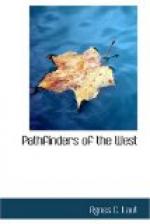[2] I have throughout referred to Medard Chouart, Sieur des Groseillers, as simply “Groseillers,” because that is the name referring to him most commonly used in the State Papers and old histories. He was from Charly-Saint-Cyr, near Meaux, and is supposed to have been born about 1621. His first wife was Helen Martin, daughter of Abraham Martin, who gave his name to the Plains of Abraham.
[3] This is the story of Onondaga which Parkman has told. Unfortunately, when Parkman’s account was written, Radisson’s Journals were unknown and Mr. Parkman had to rely entirely on the Letters of Marie de l’Incarnation and the Jesuit Relations. After the discovery of Radisson’s Journals, Parkman added a footnote to his account of Onondaga, quoting Radisson in confirmation. If Radisson may be quoted to corroborate Parkman, Radisson may surely be accepted as authentic. At the same time, I have compared this journal with Father Ragueneau’s of the same party, and the two tally in every detail.
[4] See Jesuit Relations, 1657-1658.
[5] Letters of Marie de l’Incarnation.
[6] See Ragueneau’s account.
[7] See Marie de l’Incarnation and Dr. Dionne’s modern monograph.
[8] This account is drawn mainly from Radisson’s Journal, partly from Father Ragueneau, and in one detail from a letter of Marie de l’Incarnation. Garneau says the feasters were drugged, but I cannot find his authority for this, though from my knowledge of fur traders’ escapes, I fancy it would hardly have been human nature not to add a sleeping potion to the kettles.
[9] The festins a tout manger must not be too sweepingly condemned by the self-righteous white man as long as drinking bouts are a part of civilized customs; and at least one civilized nation has the gross proverb, “Better burst than waste.”
CHAPTER III
1658-1660
RADISSON’S THIRD VOYAGE
The Discovery of the Great Northwest—Radisson and his Brother-in-law, Groseillers, visit what are now Wisconsin, Minnesota, Dakota, and the Canadian Northwest—Radisson’s Prophecy on first beholding the West—Twelve Years before Marquette and Jolliet, Radisson sees the Mississippi—The Terrible Remains of Dollard’s Fight seen on the Way down the Ottawa—Why Radisson’s Explorations have been ignored
While Radisson was among the Iroquois, the little world of New France had not been asleep. Before Radisson was born, Jean Nicolet of Three Rivers had passed westward through the straits of Mackinaw and coasted down Lake Michigan as far as Green Bay.[1] Some years later the great Jesuit martyr, Jogues, had preached to the Indians of Sault Ste. Marie; but beyond the Sault was an unknown world that beckoned the young adventurers of New France as with the hands of a siren. Of the great beyond—known to-day as the Great Northwest—nothing had been learned but this: from it came the priceless stores of beaver pelts yearly brought down the Ottawa to Three Rivers by the Algonquins, and in it dwelt strange, wild races whose territory extended northwest and north to unknown nameless seas.




